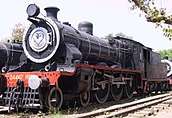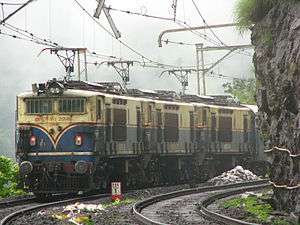Indian locomotive class WAP-7
The Indian locomotive class WAP-7 is a class of 25 kV AC electric locomotives that was developed in the 1999 by Chittaranjan Locomotive Works (CLW) for Indian Railways. The model name stands for broad gauge (W), AC Current (A), Passenger traffic (P) engine, 7th generation (7). They entered service in 2000. A total of 1086 WAP-7 have been built, with more units being built at CLW, Diesel Locomotive Works (DLW) and Diesel-Loco Modernisation Works(DLMW).
| WAP-7 | |||||||||||||||||||||||||||||||||||||||||
|---|---|---|---|---|---|---|---|---|---|---|---|---|---|---|---|---|---|---|---|---|---|---|---|---|---|---|---|---|---|---|---|---|---|---|---|---|---|---|---|---|---|
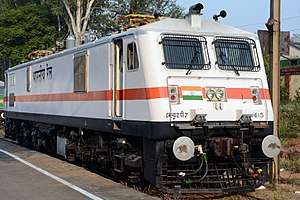 A newly built WAP-7 at CLW | |||||||||||||||||||||||||||||||||||||||||
| |||||||||||||||||||||||||||||||||||||||||
| |||||||||||||||||||||||||||||||||||||||||
| |||||||||||||||||||||||||||||||||||||||||
| |||||||||||||||||||||||||||||||||||||||||
The WAP-7 is one of the most successful locomotives of Indian Railways serving passenger trains for over 20 years. It is a passenger variant of the WAG 9 freight locomotive with a modified gear ratio to pull lighter loads at higher speeds. It is the most powerful passenger locomotive in the Indian Railways fleet, capable of hauling 24 coach trains at speeds 110–140 km/h (68–87 mph).
History
It is now largely used by Northern Railways (NR), South Central Railways (SCR), Central Railways (CR), South East Central Railways (SECR), South Eastern Railways (SER), West Central Railways (WCR), Eastern Railways (ER), Western Railways (WR), North Central Railways (NCR), South Western Railways (SWR), Southern Railways (SR), East Central Railways (ECR), East Coast Railways (ECoR) etc among other zones. As of June 2020, all of which are fitted with H-type transition couplers which are compatible with both screw coupling and centre-buffer coupling. In February 2017, Diesel Locomotive Works built their first WAP 7 class locomotive.[2]
Performance
With a maximum speed rating of 140 km/h (87 mph) the WAP-7 has the highest acceleration figures while hauling mail/express trains. The WAP-7 can also haul loads of 24-26 passenger coaches (1,430–1,550 t or 1,410–1,530 long tons or 1,580–1,710 short tons at 130 km/h or 81 mph). It is the most successful passenger locomotive on the Indian Railways roster after the WAP 4. It was initially used to haul premium train services like the Rajdhani Express, Shatabdi Express and the Duronto Express.[3] As more locomotives were rolled out, the WAP 7 became the official link of several state trains like the Telangana Express, Kerala Express, Paschim Express, Purushottam express, Vikramshila express, Poorva express, Karnataka express and among others. The locomotives have been used as a regular link for many of the Garib Rath express and many Humsafar express services and eventually extended to a significant number of AC Express and Mail/Superfast Express services like Jaipur Superfast Express, Thiruvananthapuram Mail, Mangalore Mail, Bangalore Mail, Sewagram express, Panchvati Express, Vaigai Express and so on. It is soon to be the most commonly used passenger locomotive. Upgrades are underway to increase power output and maximum speed. The First High Speed version WAP-7 HS loco (loco no 30750) was launched on 28 February 2019 capable of attaining 160 km/h with overall reduction in weight by 14 tons.
The WAP-7 locomotive can deliver 6,125 hp (4,567 kW) continuously, with regenerative braking being one of its salient features. Regenerative braking is deployed on down gradients conserving energy to the tune of 30-35 percent. It has an inbuilt microprocessor based fault diagnostic system to make troubleshooting easier.[4]
Head-on Generation (HOG)
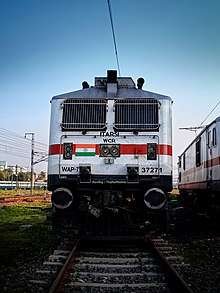
A main feature of some locomotives of this class is that they eliminate the need to have separate End on Generation (EOG) sets or DG (Diesel Generator) sets for supplying power to the train resulting in significant savings on maintenance and running costs. This technology, called HOG or "Head On Generation", transfers electric power from the loco's pantograph to the coaches instead of EOG where a power car equipped with diesel generator capable of generating adequate power of 3-phase 50 Hz 415 V / 750 V AC (called 'head-end power') is provided at either end of the train rake to supply power.[5][6][7]
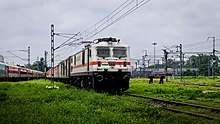
Technical Specifications
| Manufacturers | Chittaranjan Locomotive Works (CLW) Diesel Locomotive Works (DLW) Diesel Locomotive Modernisation Works |
| Traction Motors | 6FRA 6068 3-phase squirrel-cage induction motors 850 kW (1,140 hp), 2180 V, 1283/2484 rpm, 270/310A; Weight-2,100 kg (4,600 lb), forced-air ventilation, axle-hung, nose-suspended; Torque 6,330–7,140 N⋅m (4,670–5,270 lbf⋅ft) ~88% efficiency. |
| Gear Ratio | 72:20 , 70:22( for HS Version) |
| Axle load | 20.5 t (20.2 long tons; 22.6 short tons) |
| Wheel diameter | 1,092 mm (43 in) new, 1,016 mm (40 in) worn |
| Wheelbase | 15,700 mm (51 ft 6 1⁄8 in) |
| Bogies | Co-Co, Fabricated Flexicoil Mark IV bogies; bogie wheelbase 1,850 mm (72 7⁄8 in) + 1,850 mm (72 7⁄8 in) |
| Unsprung mass per axle | 3.984 t (3.921 long tons; 4.392 short tons) |
| Length over buffers | 20,562 mm (67 ft 5 1⁄2 in) |
| Length over headstocks | 19,280 mm (63 ft 3 in) |
| Body width | 3,152 mm (10 ft 4 1⁄8 in) |
| loco weight | 123 t (121 long tons; 136 short tons) |
| Cab length | 2,434 mm (95 7⁄8 in) |
| Pantograph locked down height | 4,255 mm (13 ft 11 1⁄2 in) |
Locomotive sheds
| Zone | Name | Shed Code | Quantity | Introduction | Out of Service | Notes |
|---|---|---|---|---|---|---|
| Central Railway | Ajni | AJNI | 65 | 27 December 2010 | 1 (WAP-7 #30270 is out of service due to accident damage) | First loco transferred from GZB.Locomotive WAP-7 30543 of this shed named "OJAS" |
| Kalyan | KYN | 26 | 21 June 2019 | First loco transferred from AJNI.used for PushPull Technology. | ||
| Eastern Railway | Howrah | HWH | 60 | 20 February 2012 | First loco transferred from GMO; holds the 150th electric locomotive WAP7 37025 of this shed, named "ASWAMEDH" | |
| Sealdah | SDAH(D) | 30 | 01 April 2020 | Sealdah diesel loco shed that is Beliaghata(BGA) have received 10 WAP-7 locomotives in April from Howrah electric loco shed. | ||
| East Central Railway | Gomoh | GMO | 50 | 15 November 2018 | Recently started Holding WAP7 locos, serve all routes across East Central Railway zone. First WAP 7 shed for ECR | |
| East Coast Railway | Visakhapatnam | VSKP | 33 | 22 November 2016 | First WAP7 locomotive shed for ECoR/SCoR zone. | |
| Northern Railway | Ghaziabad | GZB | 156 | 19 May 2000 | First WAP-7 was operated by NR and Indian Railways | |
| North Central Railway | Kanpur | CNB | 45 | 31 March 2019 | First loco shed in North Central Railway zone to hold WAP7 locos | |
| Southern Railway | Erode | ED | 50 | 19 October 2017 | First loco transferred from RPM.Holds the WAP7 30573, nicknamed"CAUVERY". | |
| Royapuram | RPM | 89 | 21 January 2011 | First WAP7 locomotive shed of Southern Railway.Holds WAP7 30479, nicknamed"THANGAM". | ||
| South Central Railway | Lallaguda | LGD | 119 | 26 December 2008 | First WAP7 loco shed for South India next to Ghaziabad. 100th WAP-7 Nicknamed "SHATASHV" | |
| South Eastern Railway | Tatanagar | TATA | 38 | 18 April 2017 | First WAP7 locomotive shed for South Eastern Railway zone.(Located in extreme South eastern of Jharkhand state). | |
| Bondamunda | BNDM | 15 | 31 August 2019 | First locomotive transferred from Tatanagar shed. third WAP-7 shed of South Eastern Railway zone | ||
| Santragachi | SRC | 40 | 9 November 2017 | First loco transferred from GMO | ||
| South East Central Railway | Bhilai | BIA | 55 | 6 September 2012 | First loco transferred from GMO | |
| South Western Railway | Krishnarajapuram | KJM(D) | 8 | 29 July 2019 | First WAP7 locomotive shed of South Western Railways.1st WAP7 30576 transfer from Royapuram Shed, nicknamed"CHAMUNDI". | |
| Western Railway | Vadodara | BRC | 94 | 23 April 2016 | First WAP7 locomotive shed for Western Railway zone. Shed consists more HOG locos then Non-HOG. | |
| West Central Railway | Tughlakabad | TKD | 88 | 25 January 2013 | First loco transferred from GZB | |
| Itarsi | ET | 25 | 1 December 2018 | Holds 100th DLW WAP7 37073, nicknamed"SHATAK". | ||
| Total Locomotives Active as of 01-08-2020[9] | 1086 | |||||
Named Locos

- WAP-7 30201 Navkiran (GZB)
- WAP-7 30202 Navbharti (BIA)
- WAP-7 30203 Mangal (SDAH)
- WAP-7 30209 Navchetak (GZB)
- WAP-7 30215 Navgati (GZB)
- WAP-7 30227 Champalal (GZB)
- WAP-7 30295 Navjyoti (HWH)
- WAP-7 30329 Aurobindo (SDAH)
- WAP-7 30479 Thangam (RPM)
- WAP-7 30509 Varun (GZB)
- WAP-7 30521 Varun (GZB)
- WAP-7 30543 Ojas (AJNI)
- WAP-7 30573 Cauvery (ED)
- WAP-7 30576 Chamundi (KJM)
- WAP-7 30622 Sharavathi (KJM)
- WAP-7 30630 Kabini (KJM)
- WAP-7 30631 Hemavathi (KJM)
- WAP-7 37015 Tunga (KJM)
- WAP-7 37025 Ashwamedh (HWH)
- WAP-7 37073 Shatak (ET)
- WAP-7 37085 Shatashv (LGD)
- WAP-7 37215 Platinum (HWH)
- WAP-7 37222 Bhavani (ED)
Liveries

- This locomotive's common livery is White, Black & single Red band.
- Royapuram Electric Loco Shed has Sharon Plywood advertisement on loco's body side.
- Tatanagar Electric Loco Shed has TATA Steel advertisement on loco's body side.
- Ajni Electric Loco Shed has Haldiram's Sweets & Namkeens advertisement on loco's body side.
- Bhilai Electric Loco Shed has Goel TMT advertisement on loco's body side.
- Erode Electric Loco Shed has Porna Chicken advertisement on loco's body side.
- Kalyan Electric Loco Shed has Mission Raftaar Push-Pull livery.
Accidents
On 10 July 2011, Kalka Mail derailed on the Kanpur-Fatehpur line near the Fatehpur railway station, more than 72 persons died and 200 were injured, some critically. The train was hauled by a Ghaziabad-based WAP 7 30221. Malfunction of the undergear of the locomotive may have been a reason. The driver of the Kalka Mail said he saw the engine shaking.[10] A post-accident diagnostic revealed that the first axle (leading) of the locomotive registered a jerk and the fourth axle (trailing bogie) showed loss of contact of the wheel with the track.[11]
On 14 December 2014, the Howrah - New Delhi Poorva Express derailed shortly after leaving Howrah, Kolkata. 11 sleeper coaches and a pantry car (A/C hot buffer car) of the rake jumped the rails in the incident. Due to the derailment occurring when the train was just skipping Liluah, and the usage of LHB coaches, the accident was contained and no casualties were reported. Like the 2011 Kalka Mail derailment, this accident also involved a Howrah-based WAP 7 locomotive.[12]
See also
References
- "Indian Railways Locomotive: 30201". IRFCA. Retrieved 30 December 2017.
- "Brief History of DLW". Ministry of Railways, Government of India. Retrieved 30 December 2017.
- "New energy-efficient loco introduced for high speed train". Economic Times. 9 February 2012. Retrieved 25 August 2012.
- "Southern Railway inducts fast locomotive". The Hindu. 18 October 2012.
- "Train had WAP-7 engine, 'black box' may reveal cause". Zee News. 9 August 2010. Retrieved 25 August 2012.
- "Recent Developments". Chittaranjan Loco works. Retrieved 25 August 2012.
- "Development of Electric locomotive with Head On Generation (HOG) facility" (PDF). Indian Railways.
- "Recent Developments". IRFCA.
- "e-Locos".
- "Engine failure behind Kalka Mail tragedy". IBN Live. 13 July 2011. Retrieved 14 July 2011.
- "Death by Design". Living Media India Limited. Retrieved 31 December 2017.
- "12 coaches of Poorva Express derail, no casualty". The Indian Express [P] Ltd. Retrieved 31 December 2017.
External links
| Wikimedia Commons has media related to Indian locomotive class WAP7. |

